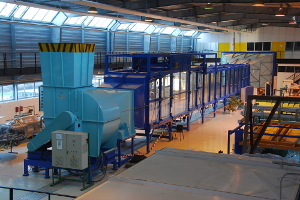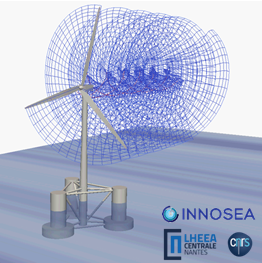
Key characteristics
This open-circuit atmospheric wind tunnel has a 26-metre long test section and a cross-section of 2 m x 2 m, with transparent walls and floor and ceiling adjustable in height. Its centrifugal fan powered by a 45kW motor allows for maximum wind speed of 10 m/s. Its characteristics make it an exceptional means for the study of offshore boundary layer intercalations with fixed or floating wind turbines.
Equipment
- 32-channel acquisition system equipped with 24 thermal anemometers dedicated to the use of single or multiple hot-wire probes,
- stereoscopic Particle Image Velocimetry (SPIV) system composed of a 200mJ Nd-YAG pulsed laser, two 4M pixels cameras with their dedicated synchronization, acquisition and post-processing unit,
- drag balance designed for the measurement of canopy element drag (< 0.5N),
- unsteady wall-pressure transducers (8 channels) and mean pressure transducers (96 channels).
Example of MRE applications
FLOATEOLE – WEAMEC Project
 Experimental characterization of the influences of platform motions on floating wind turbines aerodynamic behavior and their wake
Experimental characterization of the influences of platform motions on floating wind turbines aerodynamic behavior and their wake





